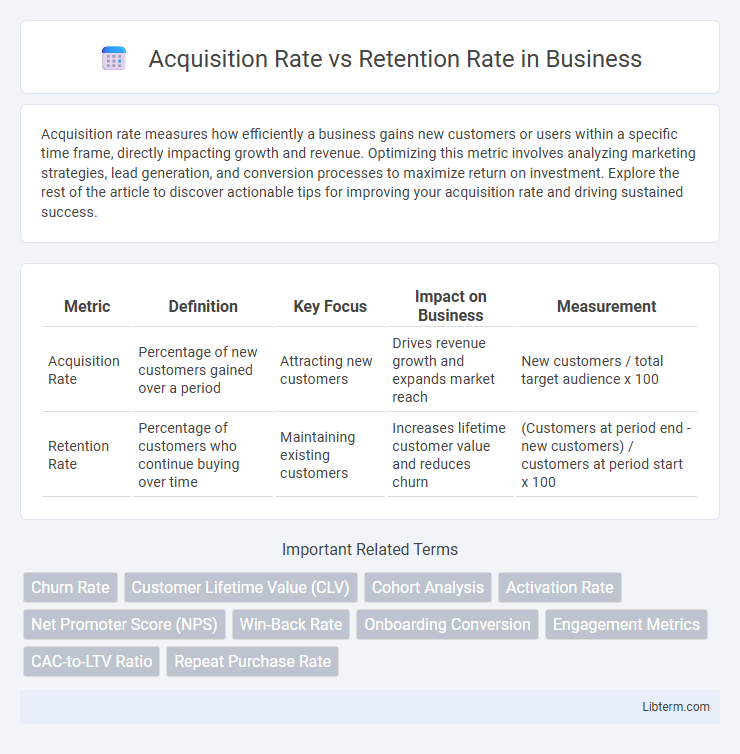Acquisition rate measures how efficiently a business gains new customers or users within a specific time frame, directly impacting growth and revenue. Optimizing this metric involves analyzing marketing strategies, lead generation, and conversion processes to maximize return on investment. Explore the rest of the article to discover actionable tips for improving your acquisition rate and driving sustained success.
Table of Comparison
| Metric | Definition | Key Focus | Impact on Business | Measurement |
|---|---|---|---|---|
| Acquisition Rate | Percentage of new customers gained over a period | Attracting new customers | Drives revenue growth and expands market reach | New customers / total target audience x 100 |
| Retention Rate | Percentage of customers who continue buying over time | Maintaining existing customers | Increases lifetime customer value and reduces churn | (Customers at period end - new customers) / customers at period start x 100 |
Understanding Acquisition Rate
Acquisition rate measures the percentage of new customers or users gained over a specific period, serving as a key indicator of a company's growth potential and marketing effectiveness. Tracking acquisition rate helps businesses allocate resources efficiently by identifying the most successful channels and campaigns driving customer inflow. High acquisition rates indicate strong market appeal but must be analyzed alongside retention metrics to ensure long-term profitability.
Defining Retention Rate
Retention rate measures the percentage of customers who continue to use a product or service over a specific period, indicating customer loyalty and long-term engagement. It is calculated by dividing the number of retained customers at the end of a period by the number of customers at the start, then multiplying by 100. High retention rates reflect strong satisfaction and can lead to increased lifetime value, reducing the need for costly acquisition efforts.
Key Differences Between Acquisition and Retention Rates
Acquisition rate measures the percentage of new customers gained within a specific period, while retention rate tracks the proportion of existing customers who continue using a product or service over time. Acquisition focuses on growth and expanding the customer base, whereas retention emphasizes customer loyalty and long-term engagement. High acquisition rates often involve marketing expenses, but high retention rates contribute more significantly to sustainable revenue and profitability.
Importance of Customer Acquisition
Customer acquisition rate measures the speed at which new customers are gained, playing a critical role in expanding market share and driving revenue growth. High acquisition rates indicate effective marketing strategies and broaden brand awareness, essential for business scalability. While retention rate reflects customer loyalty, prioritizing acquisition lays the foundation for a larger customer base and increased lifetime value.
The Value of Customer Retention
Customer retention drives long-term business growth by increasing lifetime value and reducing acquisition costs, often resulting in higher profitability compared to solely focusing on acquisition rates. Studies show that improving retention rates by 5% can boost profits by 25% to 95%, underscoring the financial impact of loyal customers. Retained customers also provide consistent revenue, enhanced brand advocacy, and lower marketing expenses, making retention strategies critical for sustainable success.
Measuring Acquisition Rate Effectively
Measuring acquisition rate effectively involves tracking the number of new customers or users gained within a specific period relative to the target market size. Key metrics include conversion rates, cost per acquisition (CPA), and channel-specific performance analysis to identify the most efficient acquisition sources. Regular analysis of these data points enables businesses to optimize marketing strategies and improve overall growth.
How to Track Retention Rate Accurately
Tracking retention rate accurately involves monitoring the percentage of customers who continue to engage with a product or service over a specific period, typically using cohort analysis to observe user behavior changes. Implementing tools like customer relationship management (CRM) systems and analytics platforms such as Google Analytics or Mixpanel provides real-time data on user activity, enabling precise measurement of retention metrics. Segmenting users by acquisition channel, demographic, and behavior further refines retention insights, allowing businesses to identify patterns and improve long-term customer loyalty effectively.
Factors Influencing Acquisition and Retention
Customer acquisition rates are primarily influenced by targeted marketing campaigns, brand visibility, and competitive pricing strategies that attract new prospects. Retention rates depend on customer satisfaction, quality of post-purchase support, personalized communication, and loyalty programs that encourage repeat business. Both acquisition and retention are affected by market conditions, product innovation, and the overall user experience, with retention typically yielding higher lifetime value.
Strategies to Balance Acquisition and Retention
Effective strategies to balance acquisition and retention involve integrating targeted customer onboarding programs that enhance early engagement and reduce churn. Leveraging data analytics to personalize marketing efforts ensures that acquisition campaigns attract high-quality leads while retention initiatives maintain customer satisfaction and loyalty. Implementing a feedback loop between acquisition and retention teams allows continuous optimization of user experience, driving sustainable growth through both new customer acquisition and long-term retention.
Optimizing Growth: Acquisition vs Retention Decisions
Maximizing business growth requires analyzing acquisition rate--the percentage of new customers gained--and retention rate--the percentage of existing customers who continue using a product or service. Data shows increasing retention by just 5% can boost profits by 25% to 95%, emphasizing the value of nurturing loyal customers over solely pursuing new acquisitions. Balancing acquisition and retention strategies based on cost-effectiveness and lifetime customer value drives sustainable, optimized growth outcomes.
Acquisition Rate Infographic

 libterm.com
libterm.com